Panasonic KV-S5055C User Manual
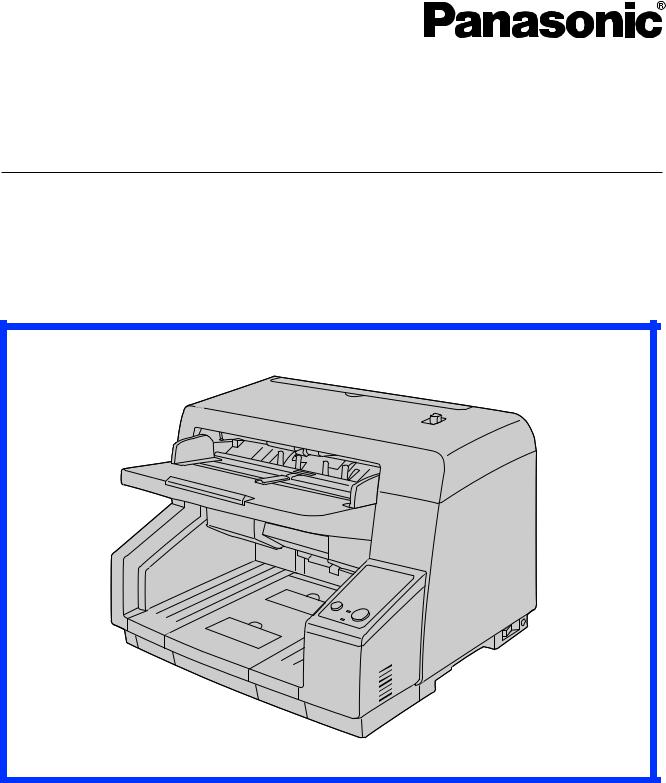
Operating Manual
High Speed Color Scanner
Model No. KV-S5055C
These instructions contain information on operating the scanner. Before reading these instructions, please read the installation manual enclosed with this unit.
Please carefully read these instructions and the enclosed installation manual. Keep all documentation in a safe place for future reference.

Introduction
Introduction
Thank you for purchasing a Panasonic High Speed Color Scanner.
Feature Highlights
Superior Paper Feeding
•This scanner features an advanced paper-feeding mechanism that adjusts the pressure of the rollers and the amount of time that the rollers are applied to the document according to the condition of the document. As a result, this scanner can scan a wide range of paper weights, from very thin 20 g/m² (5 lbs.) paper to very thick 157 g/m² (42 lbs.) paper.
High-speed Double Sided Scanning
•This scanner can scan documents at high speed, regardless of the image type (monochrome / color). Single sided: 90 pages/minute, double sided: 180 images/minute (200 dpi)
Single sided: 60 pages/minute, double sided: 120 images/minute (300 dpi) * Speeds based on scanning A4 size paper in landscape orientation.
Support for High-efficiency Scanning Jobs
•Self-cleaning function
This scanner contains an ionizer that, by emitting ions, reduces the amount of paper dust that accumulates on the scanning glass. This scanner also has self-cleaning brushes that clean paper dust off of the scanner glass.
•Stapled document detection
This scanner has a stapled document detection function that detects documents that contain staples and stops scanning before any serious damage occurs.
•Double feed detection
This scanner contains ultrasonic sensors that detect double feeding. Double feeding can be detected even if you scan documents that contain paper of various thicknesses.
•Double Feed Skip (DFS) function
If scanning has been stopped because a double feed was detected, you can easily resume scanning by pressing the Double Feed Skip key (DFS key). When you scan documents that include items that you do not want to be detected as double feeding (for example, documents that have receipts attached, envelopes, etc.), the double feed detection function can be enabled and still scan these documents.
Other Features
•You can set the left and right document guides independently. By doing so, you can reliably scan documents of differing paper sizes.
•The paper feed path can be opened widely to easily removed jammed paper and perform maintenance.
2Operating Manual

Introduction
About the documentation
The scanner documentation consists of 2 manuals: the Installation Manual and the Operating Manual. In addition, each piece of software includes the help.
Installation Manual |
The Installation Manual explains the installation method and |
(printed documentation) |
procedures. |
|
|
Operating Manual |
The Operating Manual explains the part names, operations, features |
(this manual) |
and maintenance of the unit. |
|
• You can view explanations about the settings for Panasonic Image |
|
Enhancement Technology (PIE) functions that are available on the |
|
ISIS driver screen and on the TWAIN driver screen by clicking the |
|
help button that appears on each of the software's operation |
|
screen. |
Software help |
• You can view explanations about the settings for Image Capture |
|
Plus (ICP) by clicking the help button that appears on the |
|
software's operation screen. |
|
• You can view explanations for User Utility, which is used for |
|
maintenance, by clicking the help button that appears on the |
|
software's operation screen. |
|
|
•You can also view the help for ICP and User Utility from the Windows Start menu. For details about viewing the help, see "Viewing Manuals Installed On Your Computer" in the Installation Manual.
Abbreviations
•Windows® refers to the Microsoft® Windows® operating system (hereafter Windows).
•Windows® XP refers to the Microsoft® Windows® XP operating system (hereafter Windows XP).
•Windows Vista® refers to the Microsoft® Windows Vista® operating system (hereafter Windows Vista).
•Windows® 7 refers to the Microsoft® Windows® 7 operating system (hereafter Windows 7).
Trademarks
•Microsoft, Windows, and Windows Vista are either registered trademarks or trademarks of Microsoft Corporation in the United States and/or other countries.
•ISIS and QuickScan are registered trademarks or trademarks of EMC Corporation in the United States and other countries.
•IBM and AT are trademarks of International Business Machines Corporation in the United States, other countries, or both.
•Intel and Intel Core are trademarks of Intel Corporation in the U.S. and other countries.
•Adobe and Reader are either registered trademarks or trademarks of Adobe Systems Incorporated in the United States and/or other countries.
•All other trademarks identified herein are the property of their respective owners.
Operating Manual |
3 |
|
|

Introduction
International ENERGY STAR Program
As an ENERGY STAR® Partner, Panasonic has determined that this product meets the ENERGY STAR guidelines for energy efficiency.
System Requirements
Computer |
IBM® PC/AT® or compatible machine with a CD-ROM drive |
|
|
|
|
CPU |
Intel® Core™ 2 Duo, 1.8 GHz or higher |
|
|
|
|
Operating System |
Windows XP / Windows Vista / Windows 7 |
|
|
|
|
Interface |
USB 2.0 |
|
|
|
|
Memory |
1 |
GB or higher |
|
|
|
Hard Disk |
5 |
GB or more free space is required. |
|
|
|
Note
•The above system requirements may not satisfy the requirements of all operating systems.
•The scanning speed differs depending on the host computer’s operating environment or the application used.
•Due to the slower speed of USB 1.1, it is recommended to use a USB 2.0 interface.
•If you connect the scanner to a USB hub, it is not guaranteed to work.
4Operating Manual
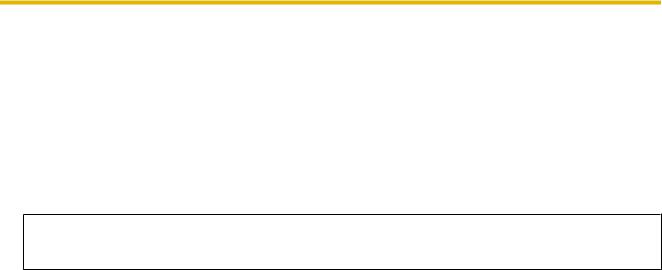
Introduction
Federal Communications Commission Requirements (For United States only)
Note
This equipment has been tested and found to comply with the limits for a Class A digital device, pursuant to Part 15 of the FCC Rules. These limits are designed to provide reasonable protection against harmful interference when the equipment is operated in a commercial environment. This equipment generates, uses, and can radiate radio frequency energy and, if not installed and used in accordance with the instruction manual, may cause harmful interference to radio communications. Operation of this equipment in a residential area is likely to cause harmful interference in which case the user will be required to correct the interference at his own expense.
FCC Warning: To assure continued FCC compliance, the user must use only shielded interface cable and the provided power supply cord. Also, any unauthorized changes or modifications to this equipment would void the user’s authority to operate this device.
For FRG Users (For Germany Only)
•Machine noise information regulation - 3.GPSGV, the maximum sound pressure level is 70 dB(A) or less, in conformity with EN ISO 7779.
•This device is not intended for use in the direct field of view at visual display workplaces. To avoid incommoding reflexions at visual display workplaces this device must not be placed in the direct field of view.
Operating Manual |
5 |
|
|

Table of Contents
Table of Contents |
|
Before You Start ....................................................................................... |
8 |
For Your Safety ................................................................................................................. |
8 |
Safety Information (For United Kingdom only) ............................................................ |
11 |
Precautions ...................................................................................................................... |
12 |
Location of Controls .............................................................................. |
14 |
Main Unit .......................................................................................................................... |
14 |
Control Panel and Status Indicators ............................................................................. |
16 |
Operation ................................................................................................ |
18 |
Turning on the Scanner Power ...................................................................................... |
18 |
Preparing Documents ..................................................................................................... |
19 |
Acceptable Documents .................................................................................................. |
19 |
Unacceptable Documents .............................................................................................. |
21 |
Scanning Documents ..................................................................................................... |
22 |
Scanning Documents with Pages of the Same Size ...................................................... |
23 |
Scanning Documents with Pages of Different Sizes ...................................................... |
30 |
Using Control Sheets ...................................................................................................... |
40 |
About Printing Control Sheets ........................................................................................ |
41 |
Changing the Scan Background Color ......................................................................... |
43 |
Switching the Reference Plate ....................................................................................... |
43 |
Care and Maintenance ........................................................................... |
46 |
Clearing Paper Jams ....................................................................................................... |
46 |
Cleaning the Scanner ..................................................................................................... |
49 |
Outside of the Scanner ................................................................................................... |
49 |
Inside of the Scanner ..................................................................................................... |
51 |
Cleaning the Conveyor ................................................................................................ |
53 |
Cleaning the Rollers .................................................................................................... |
56 |
Cleaning the Sensors and Scanning Glass ................................................................. |
60 |
Replacement Parts and Optional Units ................................................ |
64 |
Replacement Parts and Optional Units ......................................................................... |
64 |
Replacing Parts ............................................................................................................... |
65 |
Replacing the Paper Feed Roller Module ...................................................................... |
65 |
Replacing the Double Feed Prevention Roller ............................................................... |
69 |
Installing Optional Units ................................................................................................. |
74 |
Installing the Imprinter Unit ............................................................................................. |
74 |
Installing the Ink Cartridge ........................................................................................... |
77 |
Removing the ink cartridge .......................................................................................... |
79 |
Printing ........................................................................................................................ |
80 |
Appendix ................................................................................................. |
81 |
Troubleshooting .............................................................................................................. |
81 |
Shading Adjustment ....................................................................................................... |
84 |
Repacking Instructions .................................................................................................. |
85 |
Specifications .................................................................................................................. |
87 |
6Operating Manual

|
Table of Contents |
Index |
..............................................................................................................89 |
Operating Manual |
7 |
|
|
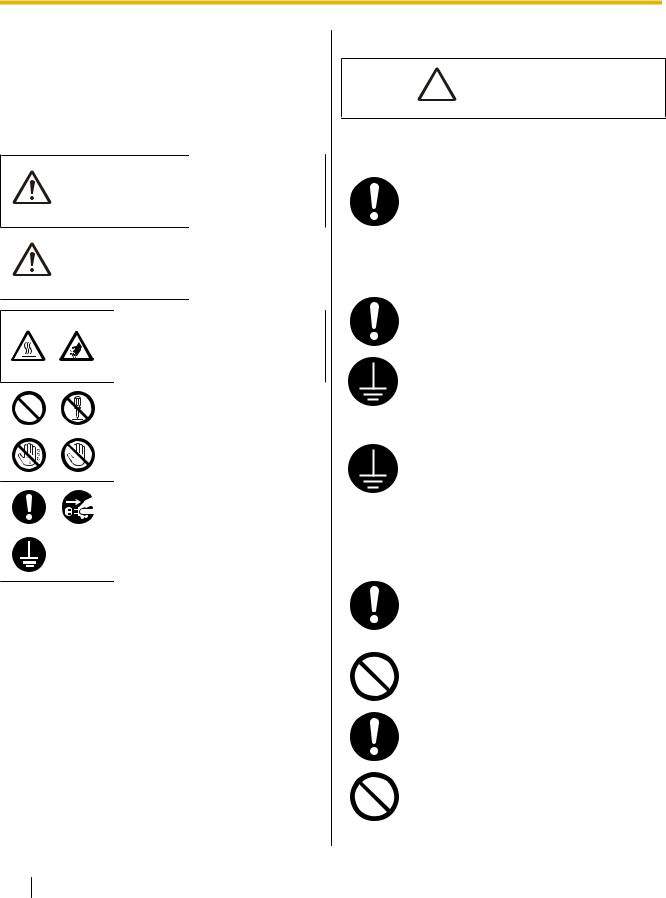
Before You Start
For Your Safety
To prevent severe injury and loss of life, read this section carefully before using the unit to ensure proper and safe operation of your unit.
•This section explains the graphic symbols used in this manual.
Denotes a potential
WARNING hazard that could result in serious
injury or death.
Denotes hazards
that could result in CAUTION minor injury or
damage to the unit.
These symbols are used to alert operators to a specific operating procedure that must be performed carefully.
These symbols are used to alert operators to a specific operating procedure that must not be performed.
These symbols are used to alert operators to a specific operating procedure that must be emphasized in order to operate the unit safely.
For Users
 WARNING
WARNING
Power and Ground Connection
The power source voltage of this unit is listed on the nameplate.
Only plug the unit into an AC outlet with the proper voltage.
If you use a cord with an unspecified current rating, the unit or plug may emit smoke or become hot to the touch.
When you operate this product, the power outlet should be near the product and easily accessible.
To ensure safe operation, the power cord supplied must be inserted into a standard three-prong AC outlet which is effectively grounded (earthed) through the normal wiring.
The fact that the equipment operates satisfactorily does not imply that the power point is grounded (earthed) and that the installation is completely safe. For your safety, if in any doubt about the effective grounding (earthing) of the power point, consult a qualified electrician.
If the plug cannot be inserted into the AC outlet, contact a licensed electrician to replace the AC outlet with a properly grounded (earthed) one.
Do not defeat the grounding (earthing) plug (ex. do not use a conversion plug).
Plug the power cord firmly into an AC outlet. Otherwise, it can cause fire or electric shock.
Do not pull, bend, rest objects on, or chafe the power cord and plug.
Damage to the power cord or plug can cause fire or electric shock.
8Operating Manual
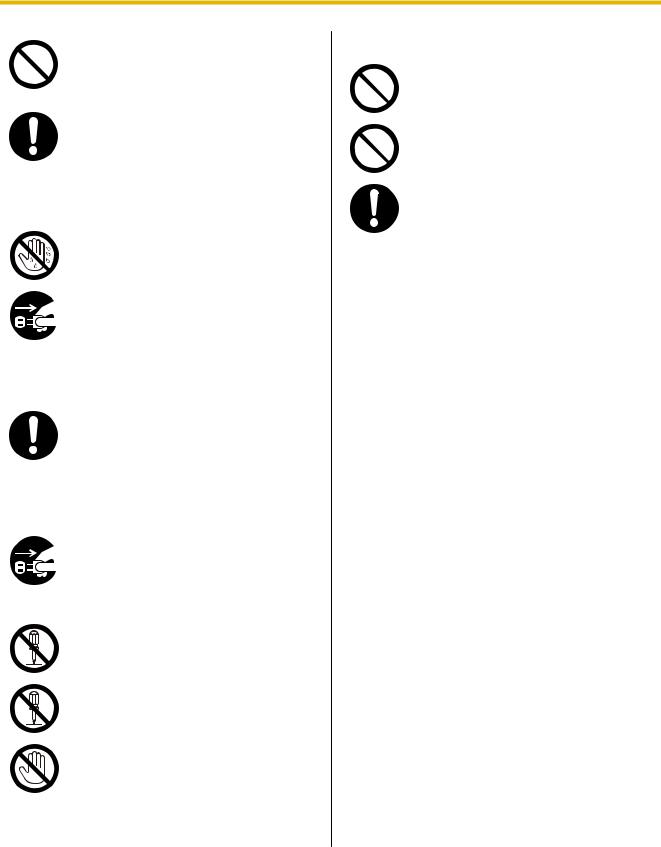
Before You Start
Do not attempt to repair the power cord or plug. If the power cord or plug is damaged or frayed, contact your dealer for a replacement.
Ensure that the plug connection is free of dust. In a damp environment, a contaminated connector can draw a significant amount of current that can generate heat, and eventually cause fire if left unattended over an extended period of time.
Never touch the plug with wet hands. Danger of electric shock exists.
Stop operation immediately if the unit emits smoke, excessive heat, abnormal smell, or unusual noise. These conditions can cause fire or electric shock. Immediately turn the unit off, and unplug the power cord, and contact your dealer for service.
When disconnecting the unit, grasp the plug instead of the cord. Pulling on a cord forcibly can damage it, and cause fire or electric shock.
Operating Safeguards
If metal fragments or water gets into the unit, turn the unit off, and unplug the unit immediately. Contact your dealer for service. Operating the contaminated unit can cause fire or electric shock.
Do not open covers, and do not attempt to repair the unit yourself. Contact your dealer for service.
Do not alter the unit or modify any parts. Alteration or modification can cause fire or electric shock.
During thunderstorms, do not touch the unit and plug. It may cause an electric shock.
Roller Cleaning Paper
Do not use the roller cleaning paper near a heater or open flame.
Do not drink or inhale the roller cleaning paper fluid including isopropyl alcohol.
The roller cleaning paper may be harmful to sensitive skin. Please use protective gloves.
Operating Manual |
9 |
|
|
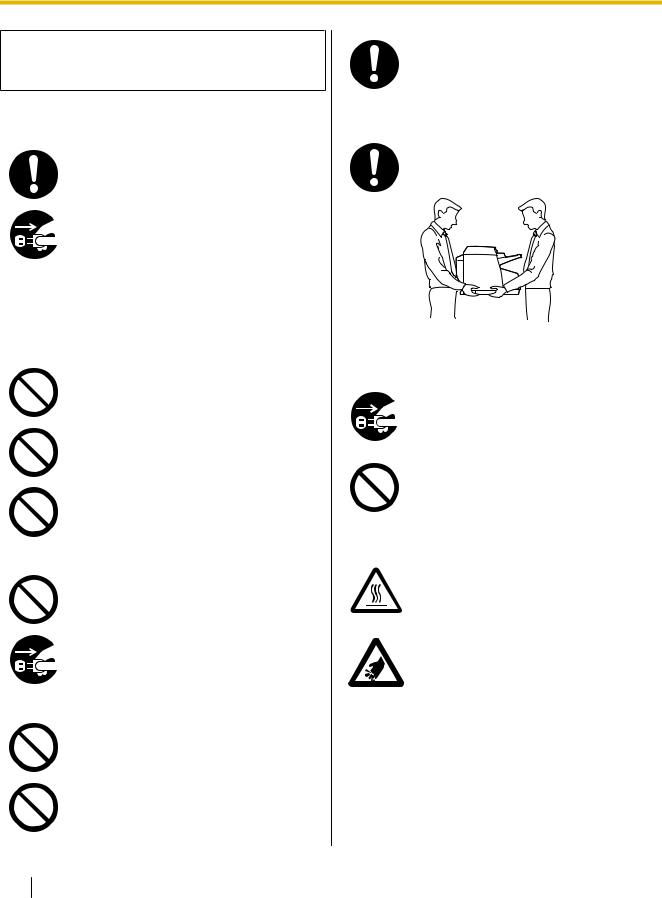
Before You Start
 CAUTION
CAUTION
Power
The unit should be used only with the power cord enclosed with the unit.
When the unit is not used over an extended period of time, switch it off, and unplug it. If an unused unit is left connected to a power source for a long period, degraded insulation may cause electric shock, current leakage, or fire.
Installation and Relocation
Do not position the unit in a location where it is unstable.
To prevent fire or shock hazard, do not expose this unit to rain or any type of moisture.
Do not place the unit in a hot humid or dusty environment.
Prolonged exposure to these adverse conditions may cause fire or electric shock.
Do not block the air vents. Doing so can cause heat to build up, and may result in fire.
When moving the unit, be sure to unplug the power cord from the AC outlet. If the unit is moved with the power cord attached, it can cause damage to the cord which could result in fire or electric shock.
Do not use the exit tray hanging out of a table.
When carrying the unit, do not use the trays as handles.
Make sure that the unit is installed in a well ventilated room so as not to increase density of ozone in the air.
Since ozone is heavier than air, it is recommended that air at floor level be ventilated.
Move this unit with two persons, and hold it by both side grips. Dropping the unit can cause injury and damage to the unit.
Operating Safeguards
If the unit falls down or gets damaged, turn the unit off, and unplug the power cord. Otherwise, it may cause fire or electric shock.
Do not place any liquids or heavy items on the unit.
Accidental spillage of liquid into the unit may cause severe damage. If this occurs, turn the unit off, unplug the power cord, and contact your dealer for service.
Do not touch the scanning glass or their surroundings immediately after continuous scanning.
This area is very hot and can cause burns.
Be careful not to pinch your fingers when closing the ADF door. It can cause injury.
10 Operating Manual

Before You Start
Safety Information (For United Kingdom only)
This appliance is supplied with a moulded three pin mains plug for your safety and convenience.
A 5 amp fuse is fitted in this plug. Should the fuse need to be replaced, please ensure that the replacement fuse has a rating of 5 amps and that it is approved by ASTA or BSI to BS1362. Check for the ASTA mark ASA or the
BSI mark  on the body of the fuse. If the plug contains a removable fuse cover, you must ensure that it is refitted when the fuse is replaced. If you lose the fuse cover, the plug must not be used until a replacement cover is obtained. A replacement fuse cover can be purchased from your local Panasonic Dealer.
on the body of the fuse. If the plug contains a removable fuse cover, you must ensure that it is refitted when the fuse is replaced. If you lose the fuse cover, the plug must not be used until a replacement cover is obtained. A replacement fuse cover can be purchased from your local Panasonic Dealer.
IF THE FITTED MOULDED PLUG IS UNSUITABLE FOR THE SOCKET OUTLET IN YOUR PREMISES, THEN THE FUSE SHOULD BE REMOVED AND THE PLUG CUT OFF AND DISPOSED OF SAFELY. THERE IS DANGER OF SEVERE ELECTRICAL SHOCK IF THE CUT-OFF PLUG IS INSERTED INTO ANY 13 AMP SOCKET.
If a new plug is to be fitted, please observe the wiring cord as shown below. If in any doubt, please consult a qualified electrician.
WARNING
THIS APPLIANCE MUST BE EARTHED.
IMPORTANT
The wires in this mains lead are coloured as follows:
Green-and-Yellow |
: |
Earth |
Blue |
: |
Neutral |
Brown |
: |
Live |
As the colours of the wires in the mains lead of this apparatus may not correspond with the coloured markings identifying the terminals in your plug, proceed as follows.
The wire that is coloured GREEN-AND-YELLOW must be connected to the terminal in the plug that is marked with the letter E or by the Earth symbol  or coloured GREEN or GREEN-AND-YELLOW.
or coloured GREEN or GREEN-AND-YELLOW.
The wire that is coloured BLUE must be connected to the terminal in the plug that is marked with the letter N or coloured BLACK.
The wire that is coloured BROWN must be connected to the terminal in the plug which is marked with the letter L or coloured RED.
How to replace the fuse:
Open the fuse compartment with a screwdriver and replace the fuse and fuse cover.
Operating Manual |
11 |
|
|

Before You Start
Precautions
Installation
•Do not place the unit in direct sunlight, in a cold draft, or near heating apparatus.
•Do not place the unit near apparatus which generate electronic or magnetic noise.
•Protect the unit from static electricity.
•Do not move the unit immediately from a cold place to a warm place. It may cause dew.
CD-ROM
•Do not write or stick paper on the front and/or back of CD-ROM.
•Do not touch the data side of the CD-ROM. When handling the CD-ROM, be careful not to leave fingerprints or otherwise damage the CD-ROM.
•Do not leave the CD-ROM where it is directly exposed to sunlight or near a heater for extended periods.
•Do not throw or bend the CD-ROM.
Roller Cleaning Paper
•Keep the roller cleaning paper out of reach of small children.
•Do not store the roller cleaning paper in direct sunlight or in a place with a temperature over 40 °C (104 °F).
•Only use the roller cleaning paper to clean the rollers and scanning glass.
•For details about the roller cleaning paper, please refer to the Material Safety Data Sheet (MSDS). Please ask your Panasonic sales company about obtaining the Material Safety Data Sheet.
KEEP AWAY FROM FIRE.
Others
•Make sure to remove paper clips and staples from documents before scanning. Failing to do so can damage the unit, document, or both.
•Do not use thinner, benzine, or cleaners containing abrasives or surfactants, for cleaning the outside of scanner.
•Plug the power cord into an outlet from which you can easily unplug it.
12 Operating Manual
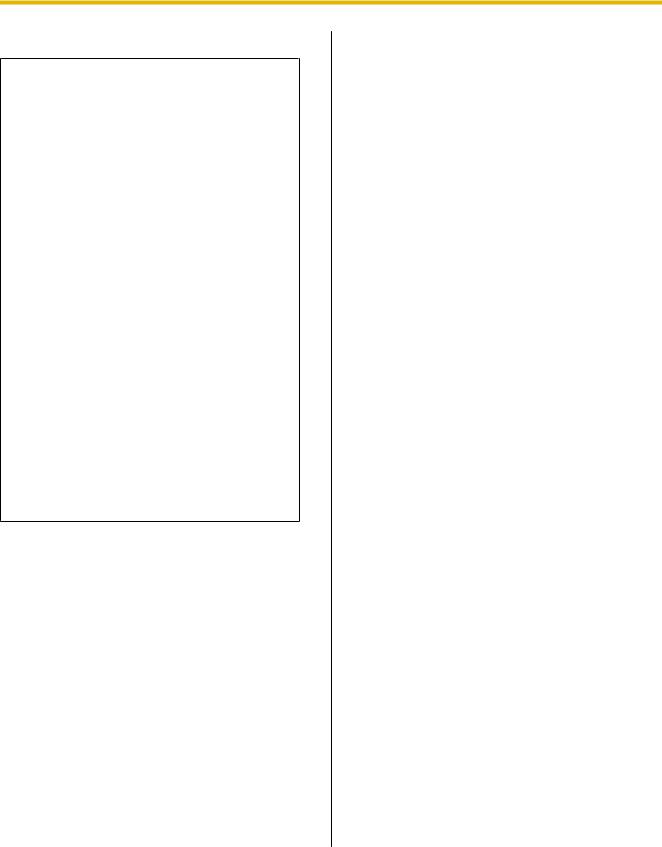
Before You Start
Illegal Duplication
It is unlawful to make duplication of certain documents.
Duplicating certain documents may be illegal in your country/area.
Penalties of fines and/or imprisonment may be imposed on those found guilty. The following are examples of items that may be illegal to duplicate in your country/area.
•Currency
•Bank notes and checks
•Bank and government bonds, and securities
•Passports, licenses, official or private documents, identification cards, and the like
•Copyright materials, or trademarks without the consent of the owner
•Postage stamps, and other negotiable instruments
This list is not inclusive, and no liability is assumed for either its completeness or accuracy. In case of doubt, contact your legal counsel.
Notice
Install your machine near a supervised area to prevent illegal duplication from being made.
Security Notice
The management of documents and scanned data is the responsibility of the user. In particular, pay attention to the following points.
•Make sure you have the same number of pages for important documents both before and after scanning, and take care not to leave any pages in the scanner.
•Periodically back up important data.
•When having your computer or hard disk serviced, or when disposing of your computer or hard disk, completely erase any stored image data.
Operating Manual |
13 |
|
|

Location of Controls
Main Unit
Front
1 |
2 |
3 |
4 |
5 |
6 |
7 |
8 |
9 |
10 |
11
12
13
14
Document guides ADF door release Hopper extension tray
Document guides selector Exit sub guide
Exit tray Exit stopper
Extension sub tray ADF door
Manual feed selector
Switches the scanning method between continuous scanning (Auto) and manual scanning (Manual).
Hopper Control Panel
For details, refer to "Control Panel and Status Indicators" (page 16).
Power switch
Ready indicator / Error indicator
For details, refer to "Control Panel and Status Indicators" (page 16).
14 Operating Manual

Location of Controls
Rear
1
2
3
4 |
5 |
Imprinter door
You open this door when installing an imprinter unit (sold separately) or ink cartridge. For details on installing an imprinter, refer to "Installing the Imprinter Unit" (page 74).
Fan exhaust vent AC inlet
Power cord
Plugs may vary in shape depending on country/area.
USB connector
Operating Manual |
15 |
|
|

Location of Controls
Control Panel and Status Indicators
1 |
2 |
|
3 4
ADouble Feed Skip key (DFS)
If you press this key when a double feed occurs, the sheet that was detected as a double feed will be scanned, and scanning will continue.
BStart/Stop key (Start/Stop)
•If you set [Wait Key] for "Manual Feed Mode"*1 in your application software, pushing this key starts scanning.
•During scanning, pushing this key stops scanning.
•If you press this key when a double feed occurs, the sheet that was detected as a double feed will be ejected from the scanner without being scanned. Scanning will stop.
CReady indicator (Ready)
Shows the scanner's status.
DError indicator (Error)
Lights when an error occurs.
*1 |
For details on "Manual Feed Mode", refer to the help for ICP. |
|
16 Operating Manual

Location of Controls
The status of the scanner is displayed by the ready indicator (C) and the error indicator (D), as shown in the table below:
C Ready indicator |
D Error indicator |
Status |
|
(Green) |
(Red) |
||
|
|||
|
|
|
|
ON |
OFF |
Ready |
|
|
|
|
|
ON |
Blink (Slow) |
Caution*1 |
|
|
|
|
|
OFF |
ON |
Error*1 |
|
|
|
|
|
Blink (Slow) |
OFF |
Sleep |
|
|
|
|
|
Blink (Slow) |
Blink (Slow) |
Caution*1 / Sleep |
|
|
|
|
|
Blink (Fast) |
OFF |
Warming up |
|
|
|
|
|
Blink (2 times consecutively) |
OFF |
Double Feed Skip mode |
|
|
|
|
*1 |
Check the status of the scanner using User Utility. |
|
Operating Manual |
17 |
|
|
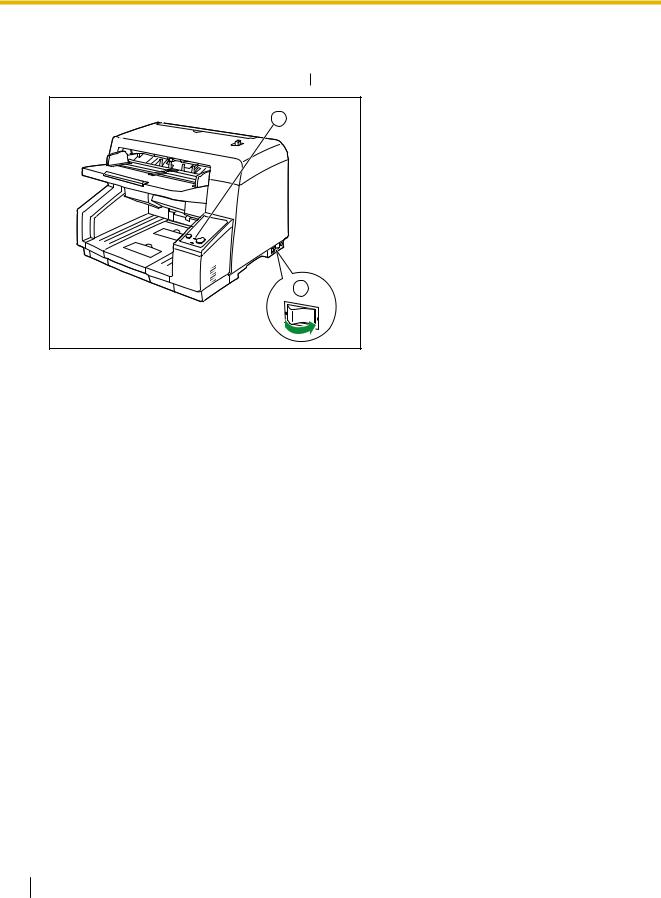
Operation
Turning on the Scanner Power
1. Set the power switch (A) of the scanner to " " (ON).
2 |
1 |
•The ready indicator (B) lights green.
18 Operating Manual

Operation
Preparing Documents
Acceptable Documents
The acceptable documents for this scanner are as follows.
Document size
48 - 297 mm
(1.9 - 11.7 in.)
70 - 432 mm
(2.75 - 17 in.)
Paper thickness: 20 – 157 g/m² (5 – 42 lbs.)
•You can place up to 200 sheets of fresh, 75 g/m² (20 lbs.) paper on the hopper at one time.
Note
•When you set a document, make sure that its height does not exceed the limit mark on the document guides.
Recommended paper: Plain paper
Document types
• |
Plain paper |
• |
Recycled paper |
• |
Bond paper |
• |
OCR paper |
• |
Newspaper |
• |
Bank checks |
• |
Carbonless copy paper |
• |
Tracing paper |
|
|
|
|
Documents must also meet the following conditions
Feeding direction Less than 
Curl 10 mm (0.4 in.)
Feeding direction Less than 
Folding 10 mm (0.4 in.)
Operating Manual |
19 |
|
|

Operation
For documents with mixed page sizes and thicknesses
Document thickness |
The ratio of page thickness between the thickest and thinnest |
|
pages must be less than 1.5. |
||
|
||
|
|
|
|
The ratio of width and height between the largest page and smallest |
|
|
page must be less than 1.5. |
|
Document size |
Example: If the smallest page is A4 size, then the largest page can |
|
|
be up to A3 size, and if the smallest page is A6, then the largest |
|
|
can be A5. |
|
|
|
20 Operating Manual

Operation
Unacceptable Documents
The following types of documents may not scan properly:
•Torn or frayed documents
•Curled, wrinkled or folded documents
•Carbon paper
•Thick or irregular documents such as envelopes, documents that are glued together, etc.
•Perforated or punched paper
•Coated paper
Do not scan the following types of paper:
•Thermal paper
•Photographs
•OHP sheets, other plastic films, cloths, or metallic sheets
•Paper with irregularities such as paper clips, staples, paste, or glue
•Document with wet ink or cinnabar seal ink
•Non-rectangular or irregularly shaped paper
Notes about documents for scanning
•Depending on the paper type, scanning results may be poor when you scan unacceptable documents, or even documents that should be acceptable.
If scanned images are skewed, paper jams occur, or double feeding occurs, try scanning again after doing the following:
–Clean the rollers and sensors.
–Reduce the number of sheets of paper loaded on the hopper.
–Change the orientation of documents placed in portrait orientation to landscape orientation, or vice versa.
–In the scan settings, set "Feeding Speed" to [Slow].*1
–Scan the documents using manual scanning.
•When using stapled document detection, completely flatten any curling or creases on the rear end of the document, and then perform scanning.
*1 |
For details about configuring the scan settings, refer to the ICP or PIE help. |
|
Operating Manual |
21 |
|
|

Operation
Scanning Documents
This scanner can scan documents whose pages are all the same size and documents whose pages are different sizes.
Notice
•Make sure to remove paper clips and staples from documents before scanning. Failing to do so can damage the unit, document, or both.
•Curled documents may cause a paper jam or damaging the document, therefore, set the document flat before scanning.
•When scanning important documents, confirm that the number of scanned images matches the number of pages in the document.
•Remove documents from the exit tray after they have been scanned.
22 Operating Manual
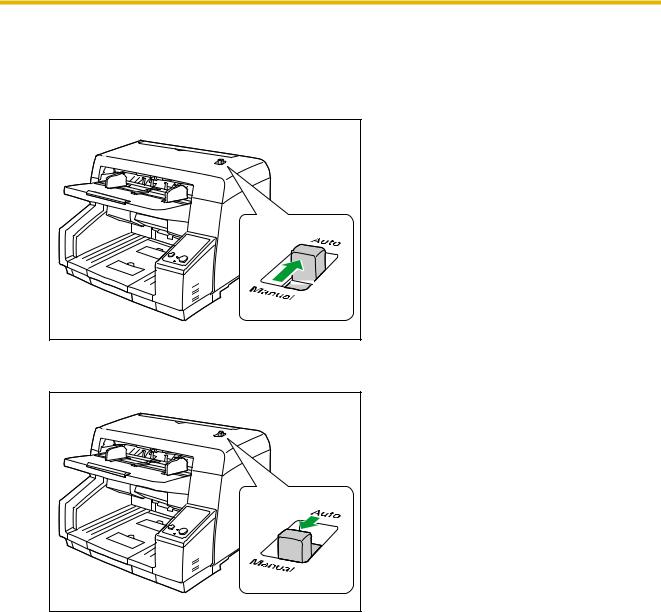
Operation
Scanning Documents with Pages of the Same Size
1.Use the manual feed selector to select continuous scanning (Auto) or manual scanning (Manual).
Continuous scanning (Auto)
Manual scanning (Manual)
Notice |
|
• |
When scanning a document manually (Manual), feed the document 1 page at a time. |
• |
When scanning important documents or bound documents, feed them manually. |
Note
•When scanning a document manually (Manual), the double feed detection function is disabled.
Operating Manual |
23 |
|
|

Operation
2. Adjust the document guides (A) slightly larger than the actual size of the documents.
1
3.Fan the documents.
•Documents that have been stapled together or stacked together (as in a file folder) will need to be separated.
Fan the stack of documents to separate all the edges.
Hold both ends and bend the documents as shown in the illustration.
To flatten the documents, hold firmly and pull them apart as shown in the illustration.
1
2 |
3 |
Repeat these steps as necessary.
4. Carefully align the documents.
24 Operating Manual
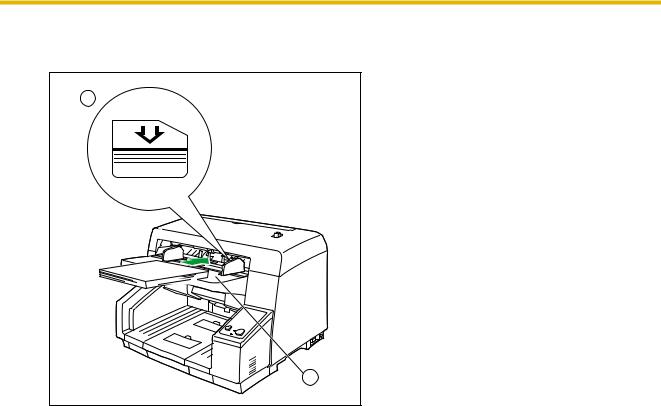
Operation
5.Place the documents on the hopper (A) with the side to be scanned facing up. Then push the documents in the direction of the arrow until they stop.
2
1
Notice
•The height of the documents should not exceed the limit mark (B) on the document guide. This may cause a paper jam or skewing.
Operating Manual |
25 |
|
|
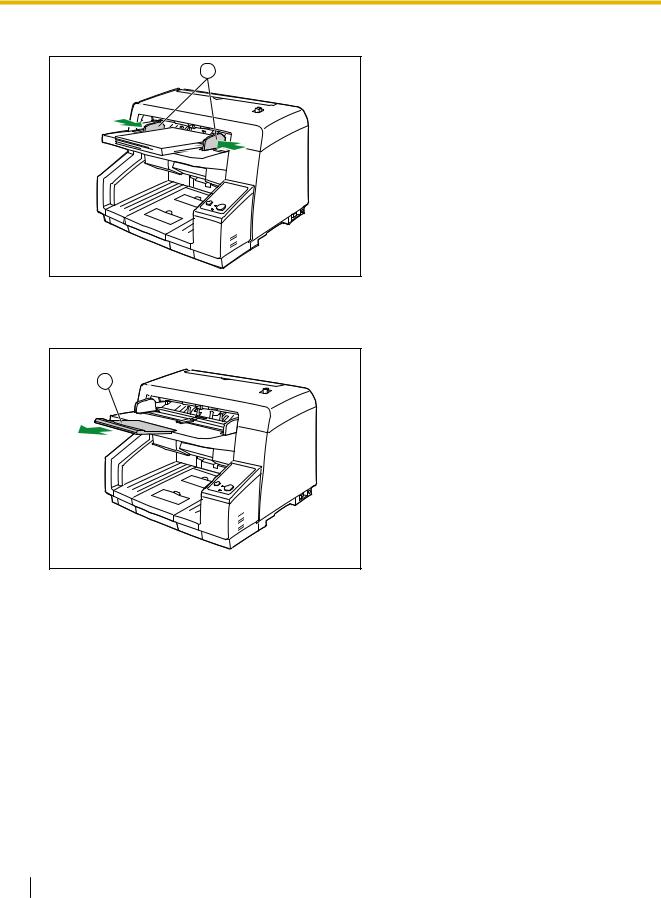
Operation
6. Slide the document guides (A) to match the width of the document to be scanned.
1
When scanning long sheets of paper
Pull out the hopper extension tray (B) from the hopper.
2
26 Operating Manual
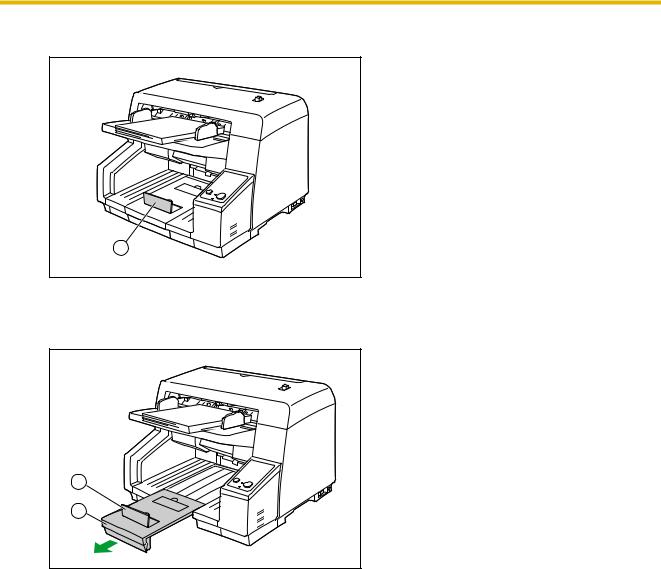
Operation
7. Raise the exit stopper (A).
1
When scanning long sheets of paper
Adjust the exit stopper (B) and extension sub tray (C) to match the size of the document.
2
3
Operating Manual |
27 |
|
|

Operation
When scanning short sheets of paper
When scanning documents like the one shown in the figure below, fully raise the exit stopper (D), and adjust the extension sub tray (E) to match the size of the document.
Scanning direction
 Document
Document
4
5
28 Operating Manual
